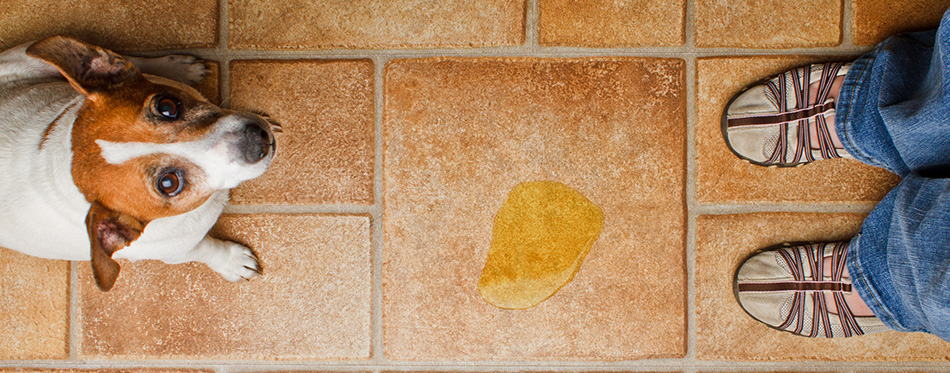It’s an experience almost every dog owner is familiar with: coming home to a chewed up shoe, broken vase, or mess on the carpet, only to find our precious pooch giving us those guilty puppy dog eyes. If the phenomenon of ‘dog shaming’ is anything to go by, this experience is practically universal, but since the canine mind is so different from our own homo sapien nurouns, the question stands – can our dogs really feel something akin to guilt?
Can Dogs Really Feel Guilt?
Back in 2015, researchers at the University of Cambridge, England, set out to explore this important question. One researcher, Dr Ljerka Ostojic, believes that the answer is a resounding no. In the Cambridge study, owners told their dog not to eat a biscuit that was left within their reach. When the owner left the room, a researcher would either remove the biscuit themselves, or encourage the dog to eat it. Upon returning to the room, owners were asked to determine whether or not their precious pooch had devoured the snack, based on their behavior and facial expressions.
The results were clear: owners were not able to tell whether or not their dog had demolished the tasty treat against their orders. “If that guilty look is really an expression of contrition”, Ostojic reported, “they [dogs] would only show it when they have done wrong. But that’s not the case”.
An earlier study, conducted by Dr Susan Hazel at the University of Adelaide, Australia, agrees. According to Hazel, “it’s pretty clear that dogs don’t feel or display guilt”. She added that “It’s just not how their brains work.”
The significant body of evidence suggesting that canine ‘guilt’ is just a human projection could have profound effects on how we interact with, and train, our dogs. In other words, it’s probably not possible to ‘shame’ a dog into good behavior.
Not every researcher agrees with these findings, however. According to cognitive ethologist, Dr Marc Bekoff, dogs have similar neurological structures to mammals that can experience complex, social emotions like guilt. In fact, Bekoff states that “Existing data do not tell us that dogs are unable to feel guilt or shame.” Part of the problem is interpretation: our dogs can’t just tell us whether they feel guilty, so any experiment involving dogs and owners will only reveal whether or not humans are good at recognizing guilt, not if their pets can actually feel it.
Things get even more complicated when we ask another difficult question: what is guilt anyway? According to Elaine Henley, an animal behaviorist and lecturer, complex emotions like shame, guilt, and jealousy are just human concepts. She suggests that we should be “careful” when it comes to “attributing human emotions to dogs”. Dr Bonnie Beaver of Texas A&M University agrees. “Since animals ‘live in the moment’… it is doubtful they know the feeling of guilt as we do”.
Head over to our reviews of Dog Whistles and Dog Silencers for more choices.

What Else Could Explain ‘Guilty’ Behavior?
The jury is still out on whether or not our canine pals can feel what we’d call ‘guilt’. Whatever the answer, we can’t dismiss the overwhelming anecdotal evidence of dogs who hide, whimper, and pull their ears back when they’ve done something wrong – before their owner even finds the mess or broken ornament.
If it isn’t guilt, what could make our pets behave this way? Some experts believe that these behaviors are a response to their owner’s actions, facial expression, and tone of voice. If you come home to a pup-related mess, chances are you’ll become frustrated, and speak to your dog in a firm, or accusatory tone. Whether or not our dogs can feel guilt, it’s pretty well-established that they can feel fear. Pinned back ears, hiding, and other submissive behavior indicate that your dog is afraid of punishment, rather than feeling guilty.
One study, conducted back in 2009, showed that dogs appeared ‘guilty’ most often when they were scolded by their owners – regardless of whether or not they’d done anything wrong. This evidence suggests that doggy ‘shame’ is actually doggy fear, in response to an irritated owner.
If your dog exhibits these ‘guilty’ behaviors before you come across their misdeed, fear could also be the culprit. We all know that dogs are intelligent animals, with surprisingly long memories. In fact, dogs are more than capable of connecting certain behaviors with a frustrated owner, so they may be preemptively afraid when they’ve done something they know has led to a telling off in the past.
So what does this behavior achieve? When they appear submissive, your dog is probably trying to calm you down, by showing you that you’re ‘top dog’. In a wild pack, this type of behavior can defuse tense situations, as one dog shows another that they aren’t a threat. In other words, these behaviors could be an attempt on your dog’s part to avoid punishment.
Animal Emotions Through History
However dogs experience emotions, one thing is clear – they do experience them. This point of view is very different to the beliefs held by earlier scientists and philosophers. Back in Renaissance Europe, philosophers such as René Descartes – famed for his profound observation “I think, therefore I am” – suggested that animals were more akin to machines than humans.
In the wake of new scientific discoveries, it became clear that even biology was governed by physical and chemical processes. This revelation threw the idea of a divine soul into question, which led to the suggestion that humans and animals differed in one fundamental way: humans possessed consciousness, and an immaterial soul, while animals did not. Nicholas de Malebranche, a French philosopher and contemporary of Descartes, went to far as to claim that animals “eat without pleasure, cry without pain, act without knowing it: they desire nothing, fear nothing, know nothing.” These mechanistic ideas suggested that what we might perceive as emotions were really just pre-programmed responses to stimuli. Renaissance thought would suggest that dogs don’t feel guilt because they don’t feel anything.
As we came to learn more about the brains of humans and dogs, however, it became increasingly clear that we’re not so different after all. Many of the structures that produce emotions in the human brain are also present in dogs.
The Canine Emotional Spectrum
As we mentioned in an earlier article, ‘25 Amazing Facts about Dogs’, our canine pals perceive color in a very different way to humans. Although they’re not color blind, as popular myth would have it, they do experience a limited spectrum compared to the human eye. Although it’s incredibly difficult to gauge, some scientists believe that canine emotions might fall on a similarly stripped back spectrum.
In studies of dog intelligence, many researchers have concluded that the average canine mind is roughly equivalent to that of a two and a half year old human child. At this age, children already possess a substantial range of emotions. However, more complex feelings; pride, shame, contempt, and of course guilt, are yet to appear. If the comparison between dog and child holds true, we can assume that dogs don’t quite have the cognitive complexity to experience guilt or shame.
However, we shouldn’t undersell a dog’s ability to experience emotion altogether. If the comparison between pooches and toddlers holds true, then our canine companions are more than capable of experiencing:
- Excitement
- Distress
- Contentment
- Disgust
- Fear
- Anger
- Joy
- Suspicion and shyness
- Love and affection
Dogs have many of the same hormones that we do, suggesting at least some similarities between their emotional lives and ours. For instance, our pooches can release the so-called ‘love drug’, oxytocin, when cuddling up to us. This strongly suggests that our canine companions love us in a way that we can comprehend.
It’s not quite so simple, however – some researchers, including Dr Bekoff, questions “the value of comparing young humans with other animals”, adding that he doesn’t find these comparisons to be “especially compelling”. Such direct comparison is very much tied up with the idea of human exceptionalism – the notion that we humans are the default setting when it comes to intelligence and complexity. Bekoff suggests that we should “appreciate other animals for who they are” rather than compare them to ourselves.
You may also like our articles on Dog Treadmills and Dog Agility Tunnels.

Conclusion
In spite of all this research, we still don’t know whether or not our dogs can experience guilt. Although they have similar emotional ‘hardware’ to humans, and produce similar hormones, behavioral studies suggest that dogs don’t experience socially complex feelings like guilt, pride, or jealousy.
We may never know if dogs can feel guilt in the same way that we do, but despite the mystery one thing is clear. Our pets have rich emotional lives, and it’s important to recognize this fact, and treat them accordingly. ‘Shaming’ a dog into good behavior probably won’t work, whereas patience and appropriate praise can lead to a happy, calm, pet.

